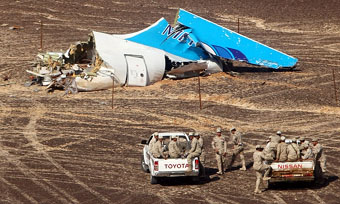
U.S. Satellites Detected Heat Before Crash
| published November 3, 2015 |
By Thursday Review staff
A doomed Russian passenger plane emitted a large heat signature while still in the air at—or near—its cruising altitude, and right up into the final seconds before it broke apart, sending debris falling into remote areas of Egypt’s Sinai Peninsula.
The heat signature, which was infrared in origin, was seen and recorded by U.S. satellite systems. Experts in Egypt, Russia and other countries stress, however, that this does not immediately narrow the list of possibilities of what caused the midair explosion and breakup of a Metrojet Airbus A321, which left the Egyptian coastal resort of Sharm el-Sheikh on its way back home to St. Petersburg, Russia before crashing in the Sinai. The plane had been in the air about 25 minutes when it suddenly began losing altitude, soon vanishing from radar.
Investigators are also quick to point out that they do not believe that evidence supports the theory that the passenger airliner was shot down using a surface-to-air missile, despite repeated and vigorous claims of responsibility by an ISIS-linked militant group which operates in the Sinai. Military experts and intelligence officials say they do not believe that ISIS groups in Egypt, or any of their affiliates, have access to the type of sophisticated weapon required to hit a plane at 30,000 feet.
However, a minority of intelligence experts have told the press that it is well within the realm of possibility that such a weapon could have fallen into the hands of ISIS in northern Iraq or northern Syria, then, transported to Egypt or smuggled into the area through Jordan or Saudi Arabia.
But U.S. aviation officials say that the infrared heat plume could also indicate several other possibilities, including an on-board bomb, a catastrophic engine failure, or some form of accidental ignition in the cabin. Another possibility which investigators are examining: an explosion in the cargo area, the result of something improperly shipped or improperly secured.
The Egyptian government has repeatedly said it does not believe that the plane was taken down by a ground-launched rocket or anti-aircraft fire. Both Russian and Egyptian investigators have also said that audio taken from the black box reveals that in the minutes prior to the plane's break-up and explosion, sounds not consistent with normal airliner operations could be clearly heard, though officials have not concluded what those sounds are.
Russian authorities have apparently already examined the plane’s dual black boxes, but other than the abberant sounds heard on board the plane, officials are not reporting any conclusions to the media, nor have Russian officials offered theories to family members of those killed in the crash. Moscow says 224 passengers and crew died in the crash.
ISIS took to social media and the internet a few hours after the crash to take credit for the downed plane, claiming it had shot the airliner from the sky as retaliation for Russia’s recent military actions in Syria on behalf of the government of Bashir al-Assad. Russia has deployed troops to Syria to back up the Assad regime, and last month began an air campaign which includes bombing, surgical strikes and cruise missiles.
But experts point out that ISIS often takes credit for military actions or terrorist acts which members of its army have not committed. In Cairo, officials have urged the international media to allow the investigation to proceed at pace, and have asked reporters and the press to avoid imposing artificial deadlines on what may turn out to be a lengthy investigation.
Related Thursday Review articles:
Russian Airliner: Claims and Counterclaims Over ISIS; Keith H. Roberts; Thursday Review; November 1, 2015.
Russia Sending More Weapons to Syria; R. Alan Clanton; Thursday Review; September 18, 2015.
